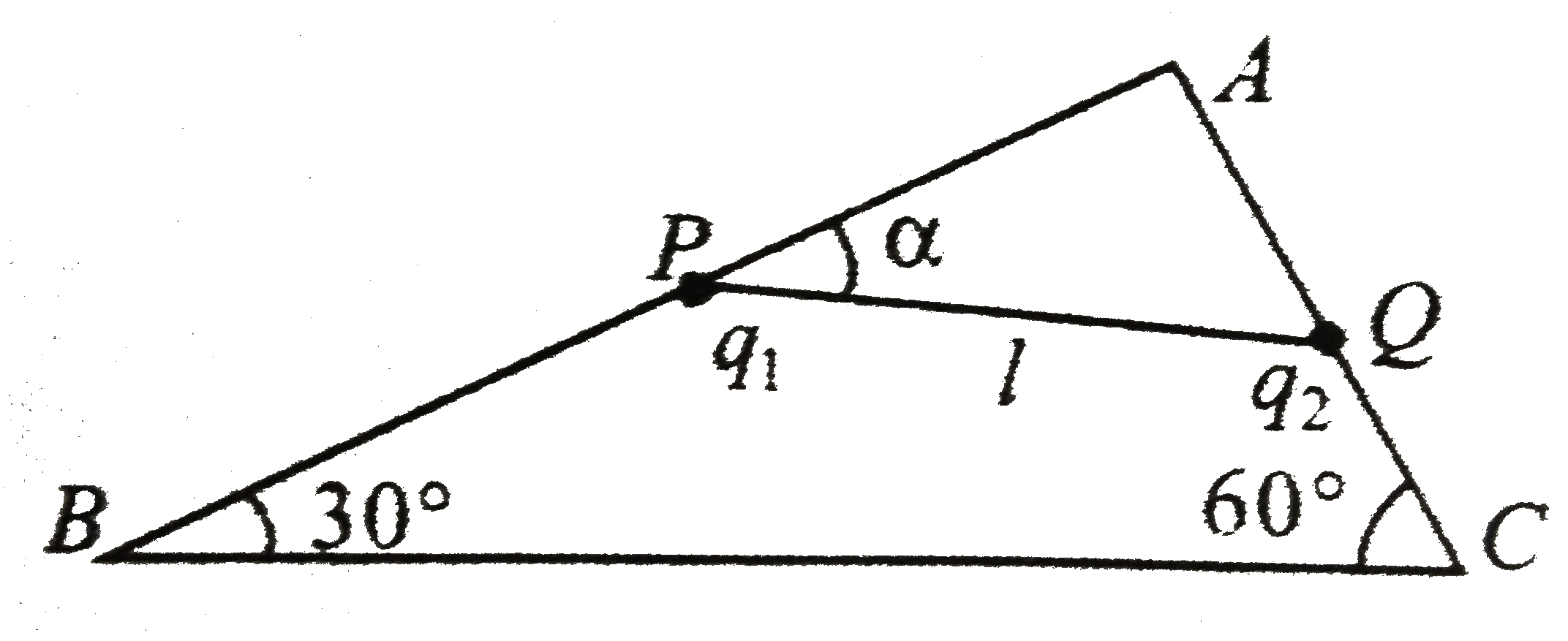Complete Solutions to Solved examples of chapter COULOMB LAW AND ELECTRIC FIELD of Class 12 book with complete answers and questions
| Class 12 | PHYSICS |
| Chapter | COULOMB LAW AND ELECTRIC FIELD |
| CENGAGE PHYSICS | Solved examples |
| Number Of Questions | 10 |
| Academic Year | 2023-24 |
Two balls of charges `q_(1)` and `q_(2)` initially have a velocity of the same nagnitude and direction. After a unform electric field has been applied for a certain time. The direction of the first ball changes by `60^(@)` and the velocity magnitude is reduced by half. The direction ofvelocity of the second ball changes by `90^(@)`. In whata ratio will hte velociyt of the second ball change? Determine, the magnitude of the charge to mass ratio of the ball if it is equal to `alpha_(1)` for the firt ball. Ignore the electrostatic interactin between the balls.
 ,
,
View SolutionA rigid insulated wire frame in the form of a right-angled triangle ABC is set in a vertical plane as shown in fig. two beads of equal masses m each and carrying charges `q_(1)` and `q_(2)` are connected by a cord of length l and can slide without friction on the wires.
Cinsidering the case when the beads are stationary, determine
(i) the angel `alpha`
(ii) the tension in the cord, and
(iii) The normal recation on teh beads.
If the cord is now cut, what are the value of the charges for which the beads continue to remain stationary?

View SolutionIn a horizontal unifrom electirc field, a small charged disk is gently released on the top of a fixed sperical dome. The disk slides down the some without friction and breaks away from the surface of the dome at the angular position `theta = sin^(-1)(3//5)` from vertical. Determine the ratio of the force of gravity acting on the disk to force of its interaction with the field .

View SolutionA charge particle A is fixed at the base of a uniform slope of inclination `alpha`. Another charge particle B is placed on the slope at an angular position `beta` measured from the line of greatest slope passing through the position of the first particle. The coefficient of froction between the particle B and the slope is `mu(mu lt tan alpha)` .For the particle at B to stay in equilibrium what would be the maximum value of the angle `beta` ?

View SolutionIn a free space, a thin rod carrying uniformly distributed negative charge `-q` is placed symmetrically along the axis of a tin ring of radius R varrying uniformly dostributed charge Q. The mass of the rod is m and length is `l=2R`. The ring is fixed and the rod is free to move. The rod is displaced slightly along the axis of the ring and then released. Find the period T to the small amplitude oscillations of the rod.
View SolutionTwo charges`+q_(1)` and `-q_(2)` are placed at A and B respectively. A line of force emanates from `q_(1)` at an angle `alpha` with the line AB. At what angle will it terminate at `-q_(2)` ?

View SolutionA small point mass m has a charge q, which is constrained to move inside a narrow frictionless cylinder, At the bae of the cylinder is point mass of charge Q having the same sign as q. If the mass m is displaced by a small amount from its equilibrium position and released. it will exhibit simple harmonic motion. Find the angular frequency of the mass?

View SolutionA non-conducting ring of mass m and radius R is charged as shown. The charge density, i.e. charge per unit length is `lamda`. It is then placed on a rough non-conducting horizontal plane. At time `t = 0`, a uniform electric field `E = E_0hati` is switched on and the ring starts rolling without sliding. Determine the friction force (magnitude and direction) acting on the ring when it starts moving.

View SolutionTwo small identical balls lying on a horizontal plane are connected by a weightless spring. One ball (ball 2) is fixed at O, and the other (ball 1) is free. The balls are charged identically as a result of which the spring length increases `eta=2` times. Determine the change in frequency.

View SolutionA non-conducting ring of mass `m` and radius `R` has a charge `Q` uniformly distributed over its circumference. The ring is placed on a rough horizontal surface such that plane of the ring is parallel to the surface. A vertical magnetic field `B = B_0t^2` tesla is switched on. After 2 a from switching on the magnetic field the ring is just about to rotate about vertical axis through its centre.
(a) Find friction coefficient `mu` between the ring and the surface.
(b) If magnetic field is switched off after `4 s`, then find the angle rotated by the ring before coming to stop after switching off the magnetic field.
View Solution
Solved examples questions and complete solutions for chapter COULOMB LAW AND ELECTRIC FIELD of CENGAGE PHYSICS (ENGLISH) of Class 12